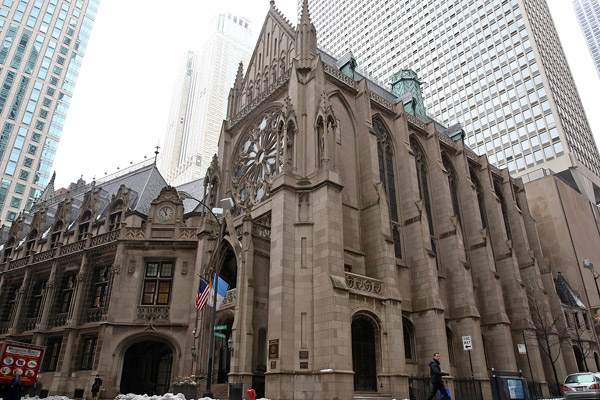
John J. Kim/Chicago Tribune
Archibishop Quigley Center, 835 N. Rush St.
I didn't meet a practicing Catholic until I got to college. Really; according to the U.S. Religion census, the area I grew up in has about 1,400-5,000 Catholics out of a population of 120,000. Cook County (population about five million) recently fell under two million Catholics. So I don't have a lot to say about the new Pope, other than that I have some Jesuit-school-educated friends, including my wife, who will be at least a little excited to have a Jesuit Pope for the first time, ever.
[To a small degree, I am interested in the overlap between papal coverage and sports-draft coverage:
One cardinal later said the conclave had been "something of a horse race" between Ratzinger and Bergoglio, and an anonymous conclave diary splashed across the Italian media in September 2005 claimed that Bergoglio received 40 votes on the third ballot, just before Ratzinger crossed the two-thirds threshold and became pope.
[snip]
Nevertheless, after the conclave of 2005 some cardinals candidly admitted to doubts that Bergoglio really had the steel and "fire in the belly" needed to lead the universal church.
You want a Pope with hustle.]
But: I am interested in employment data. And the Catholic Church is a huge employer in Chicago. The Archdiocese alone ranks 20th (13th among private employers) in the Chicago area with 7,900 employees, just behind the CTA and just ahead of Allstate, according to the most recent numbers from Crain's. (It's a big decline from Crain's 2002 list, which had the Archidiocese at just under 18,000, in a statistical tie with Motorola.)
It also controls a lot of money (via Chicago's 2005 piece on Catholics in Chicago; the economy and declining numbers mean the budget may be lower now):
The Archdiocese of Chicago has an annual operating budget of about $1 billion, a figure that combines the budgets of all parishes with other operations overseen by the Pastoral Center. Much of the revenue from this complex group of business units never passes through the center. Tithing from the parishes last year contributed about $22 million to the main office.
And most of that stays in the city:
The archdiocese is not required to send its financial statements to Rome, although every five years the cardinal travels there to report on the health of his congregation. Each year, the Chicago archdiocese—like a parish under the biggest archdiocese of all—sends a contribution to the Vatican, $400,000 last year ("less than 20 cents per Catholic in Chicago," Brennan points out).
And land. Lots and lots of it. $1,352,299,000 in land, buildings, and equipment minus accumulated depreciation, according to the Archdiocese's most recent statements (PDF), though it's very hard to estimate what that translates to in the real world.
It's actually less like a company than an small—but not that small—mirror of Chicago: balancing ongoing deficits, attrition, school closures, settlements, and declining revenues with a recent history of unbalanced budgets. The theological specifics may be foreign to us outside of the faith, but its imprint on the city remains massive.


